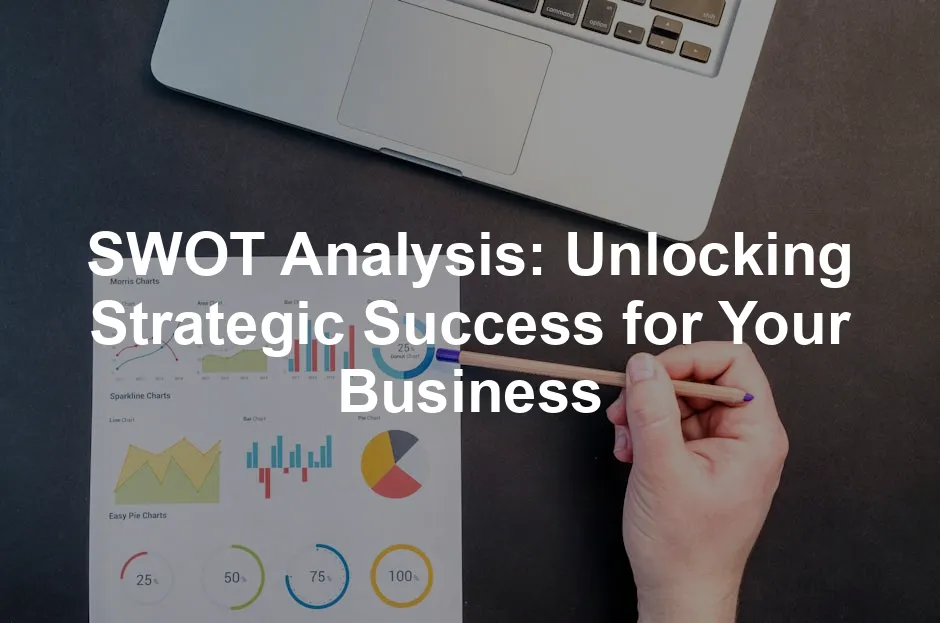Introduction
In today’s fast-paced business environment, understanding where your organization stands is crucial for long-term success. Enter SWOT analysis—a strategic tool that helps businesses map out their Strengths, Weaknesses, Opportunities, and Threats. Think of it as your business’s personal trainer, guiding you to build on your strengths while tackling weaknesses and capitalizing on opportunities. This handy framework originated from research conducted by Albert Humphrey at Stanford University in the 1960s. It has since become a go-to for organizations of all sizes, from large corporations to small startups.
Why should you care about SWOT analysis? Imagine trying to navigate a maze without a map. Confusing, right? SWOT analysis acts as that essential map, illuminating your path forward. It helps you recognize your internal strengths that give you an edge. You’ll also see weaknesses that could trip you up. On the external front, it highlights opportunities that could propel you forward and threats that might stand in your way.
Conducting a SWOT analysis doesn’t have to be a solo endeavor. Involve your team! Diverse perspectives can spark valuable insights. Brainstorming sessions not only encourage collaboration but also reveal hidden gems in your organization. Regular assessments of your SWOT analysis can keep your strategic approach agile and responsive.
So, whether you’re a seasoned entrepreneur or a startup founder, this guide will equip you with the insights to navigate your business landscape with confidence. Get ready to turn challenges into stepping stones and discover opportunities you didn’t even know existed.

Summary of Key Points
SWOT analysis serves as a foundational framework for strategic planning. It consists of four quadrants:
- Strengths (S): Internal factors that give your organization a competitive edge. Think of strong brand recognition or specialized skills.
- Weaknesses (W): Areas that require improvement or pose challenges. This could be limited resources or gaps in expertise.
- Opportunities (O): External factors that could contribute to growth and success. These often include market trends or technological advancements.
- Threats (T): External challenges that could jeopardize the organization’s stability. Competitors and regulatory changes typically fall into this category.
Understanding these elements allows you to strategize effectively. For instance, a recognized strength could be a loyal customer base, while a weakness might be an outdated product line. Opportunities can arise from emerging market needs, while threats could include new entrants in your industry.
To conduct a robust SWOT analysis, gather a diverse team, brainstorm ideas, and prioritize actionable insights. Regular assessments ensure that the analysis remains relevant as market conditions evolve. Keeping your SWOT analysis up-to-date is like recharging your organization’s GPS—essential for navigating the ever-changing business landscape.
In summary, SWOT analysis is not just a theoretical exercise. It’s a practical tool that can drive real results. By engaging with this process, you can align your internal capabilities with external possibilities, ensuring your business not only survives but thrives.

Why Use SWOT Analysis?
SWOT analysis is like having a trusty map for your business journey. It provides a comprehensive view of your organization’s current standing. You can spot your strengths that shine brighter than a diamond and weaknesses that might trip you up faster than a banana peel on the floor. This clarity helps you strategize effectively.
Additionally, SWOT analysis encourages collaboration across departments. Ever tried planning a surprise party alone? It’s tough! Just like a party, developing a strategic plan benefits from diverse insights. Involving different team members can reveal hidden gems and spark innovative ideas.
Moreover, it serves as a foundation for strategic planning, guiding decision-making. It’s like a reliable GPS that keeps you on track while navigating the twists and turns of the business landscape. By identifying strengths, weaknesses, opportunities, and threats, you equip yourself to make informed choices that propel your business forward.
Speaking of informed choices, if you’re looking to deepen your understanding of strategic frameworks, check out SWOT Analysis: A Guide to the Basics. This book will provide you with a comprehensive understanding of this strategic tool, ensuring that you can leverage it effectively in your business planning.

The Importance of Regular SWOT Assessments
Regularly revisiting your SWOT analysis is crucial. It keeps your strategic approach agile and responsive. Think of it as giving your business a regular health check-up. Just like you wouldn’t want to ignore a pesky cough, you shouldn’t overlook the changing dynamics of your environment.
This ongoing practice helps identify new opportunities and threats as your business landscape shifts. Market trends change faster than fashion, and staying updated allows you to pivot quickly. By keeping your SWOT analysis fresh, you can capitalize on emerging opportunities and dodge potential threats, ensuring your business remains resilient and competitive.
If you’re feeling overwhelmed by the process, consider The Hard Thing About Hard Things. This book provides candid insights from a successful entrepreneur who navigated the challenges of running a business, offering you practical strategies to tackle your own hurdles.
Opportunities
Opportunities are like shiny new toys in the business playground. They represent external factors that can help your organization grow and succeed. Identifying these opportunities requires a keen eye and open ears. Here are some ways to spot them:
- Market Expansion: Keep an eye on emerging markets. New demographics or geographical areas can offer fresh customer bases. For instance, a local coffee shop might consider opening a branch in a neighboring town.
- Technological Advancements: Technology is evolving faster than ever. Staying updated on tech trends can provide a competitive edge. Consider how adopting new software can streamline operations or improve customer engagement.
- Regulatory Changes: Sometimes, changes in laws can create new opportunities. For example, if a government introduces incentives for green energy, businesses in that sector could thrive.
- Consumer Trends: Pay attention to shifting consumer preferences. If customers are leaning towards sustainable products, businesses that pivot to eco-friendly offerings can capture this market.
- Partnerships and Collaborations: Collaborating with other businesses can unveil new opportunities. Joint ventures can lead to shared resources and expanded reach.
To effectively identify opportunities, conduct regular market research and engage with your customers. Surveys and feedback sessions can unearth valuable insights about what your audience desires and what gaps you can fill.

For practical tips on creating a sustainable business model, consider reading Business Model Generation. This book is perfect for those looking to innovate and adapt their business strategies to meet new market demands.
Threats
On the flip side, threats are lurking around every corner, waiting to trip you up. They represent external challenges that could jeopardize your business stability. Recognizing these threats early is crucial to prevent them from spiraling out of control. Here’s where to look:
- Economic Downturns: A recession can turn customer spending into a ghost town. Monitoring economic indicators helps you prepare for potential slowdowns.
- Competitive Pressures: Your competitors are always on the prowl. New entrants or aggressive marketing strategies can threaten your market share. Keep an eye on what your rivals are doing, and be ready to adapt.
- Supply Chain Disruptions: Global events can shake up supply chains. Natural disasters or political unrest can impact your materials. Having a contingency plan can save you from unexpected hiccups.
- Changing Regulations: New laws can impose additional costs or operational hurdles. Stay informed about industry regulations to avoid surprises that could affect your business model.
- Technological Changes: While tech can be an opportunity, it can also pose threats. Failing to keep pace with advancements can leave you behind. Regularly assess your technology stack to ensure you’re not lagging.
Identifying threats involves regular environmental scanning and strategic planning. Creating a risk management framework can help you anticipate and mitigate potential challenges before they become crises. Remember, it’s not about fearing threats; it’s about preparing for them.

For a deeper understanding of the competitive landscape, consider reading The Innovator’s Dilemma. This book will help you understand how new technologies can disrupt even the most successful organizations, providing insights on how to navigate these challenges.
Best Practices for Effective SWOT Analysis
When it comes to conducting a SWOT analysis, following best practices can significantly enhance the quality of your insights. Here’s how to make your SWOT analysis truly shine.
Encourage Diverse Perspectives
Imagine throwing a dinner party where everyone brings the same dish. Boring, right? The same goes for your SWOT analysis. Involve a diverse group of stakeholders. Include team members from various departments—marketing, finance, operations, and even customer service. Different perspectives lead to richer discussions and uncover hidden insights. The more varied the viewpoints, the more comprehensive your analysis will be. After all, the marketing team might spot opportunities that the finance team overlooks, and vice versa.
Avoid Biases in Data Collection and Analysis
Bias is like that annoying friend who always steals the spotlight. It can skew your SWOT analysis. To keep biases at bay, rely on data-driven insights. Use surveys, interviews, and market research to gather information. Encourage open discussions where all voices are heard, and avoid letting the loudest opinions dominate. Always cross-check your assumptions with factual data. This approach ensures that your analysis reflects reality rather than preconceived notions.

Integrate with Other Analytical Tools
SWOT analysis doesn’t exist in a vacuum. Think of it as one piece of a larger puzzle. Integrate it with other analytical tools like PESTLE analysis. PESTLE examines the Political, Economic, Social, Technological, Legal, and Environmental factors affecting your organization. When combined, these tools provide a holistic view of your business environment. This comprehensive understanding allows you to align strengths and opportunities more effectively, while also preparing for potential threats.
Make it a Recurring Exercise, Not a One-Time Event
Just like your gym membership, your SWOT analysis should be a regular commitment. Don’t treat it as a one-and-done task. Set a schedule to revisit and update your analysis—quarterly or semi-annually is ideal. The business landscape is constantly changing, and so should your analysis. Regular assessments will help you adapt to new opportunities and threats as they arise, keeping your strategic planning relevant and effective.
By embracing these practices, you’ll elevate your SWOT analysis and ensure it becomes a powerful tool for guiding your organization’s strategy. So rally your team, gather your data, and get ready to unlock the full potential of your SWOT analysis.
Conclusion
In conclusion, SWOT analysis is not just a strategic tool; it’s a roadmap for navigating the complexities of the business world. By understanding your organization’s strengths and weaknesses, while keeping an eye on external opportunities and threats, you can make informed decisions that foster growth and resilience. Remember, the key to effective SWOT analysis lies in regular assessment and collaboration across your organization. Make it part of your strategic planning process, and watch your business thrive.
Think of SWOT analysis as your trusty compass. It points you in the right direction by highlighting what you do well and what needs improvement. It also identifies opportunities waiting for you to grab and threats lurking in the shadows.
Plus, involving your team in this process ensures that everyone is on the same page. When diverse minds come together, the result is a well-rounded view of your business landscape. Regularly revisiting your SWOT analysis allows you to adapt to changes, keeping your strategy robust and responsive.
For those looking to improve their personal effectiveness, consider reading The 7 Habits of Highly Effective People. This book offers timeless principles that can help you lead yourself and others more effectively, enhancing your ability to execute strategic plans.

So, don’t let your SWOT analysis gather dust on a shelf. Embrace it as an ongoing conversation within your organization. Treat it as a living document that evolves with your business. By doing so, you empower your team to make proactive decisions, seize opportunities, and navigate the challenges that come your way.
With a well-executed SWOT analysis, you’re not just reacting to the business environment; you’re shaping your future. So, roll up your sleeves and get to work. Your business’s success story starts with understanding where you stand today and where you want to go tomorrow.
FAQs
What is the best time to conduct a SWOT analysis?
Timing is everything! Conducting a SWOT analysis is most effective during key moments. Before launching new products? Absolutely! This allows you to identify strengths and opportunities for a successful launch. How about during strategic planning sessions? Yes again! These sessions benefit from a fresh look at internal and external factors that could shape your direction. Additionally, it’s wise to revisit your analysis when facing significant market changes or when your organization’s goals evolve. Keeping your SWOT analysis dynamic ensures it remains relevant and useful.
Can SWOT analysis be used for personal development?
Absolutely! SWOT analysis is not just for businesses. Individuals can use it for career planning and personal goal setting. Start by identifying your personal strengths. Are you a great communicator? Do you have a strong work ethic? Next, look at weaknesses. Maybe you struggle with time management or lack certain skills. Then, focus on opportunities. Are there new courses you can take? Networking events you can attend? Finally, consider threats. Is there intense competition in your field? By applying SWOT to your personal development, you can create a roadmap toward achieving your goals.
What are some limitations of SWOT analysis?
While SWOT analysis is a fantastic tool, it does have its limitations. For starters, it can oversimplify complex situations. Not every nuance can fit neatly into the four quadrants. Additionally, bias can creep in during assessments. Personal opinions may color how strengths and weaknesses are viewed. Lastly, without regular updates, your SWOT analysis can quickly become outdated. Make it a habit to revisit and refresh your insights regularly to ensure you’re making decisions based on current realities.
How often should a SWOT analysis be revisited?
Regular check-ups are essential! Revisit your SWOT analysis at least semi-annually. This frequency allows you to capture shifts in the market or within your organization. If you’re undergoing significant changes, like a new product launch or entering a new market, consider doing it more often. The business landscape evolves faster than a chameleon on a rainbow! Staying updated ensures you’re ready to tackle new opportunities and threats as they arise. Keeping your SWOT analysis fresh is like keeping your business strategy on a well-maintained road, ready for any curveballs.
Please let us know what you think about our content by leaving a comment down below!
Thank you for reading till here 🙂
For more insights on effective data visualization techniques, check out our article on best practices for using israel central bureau of statistics data visualization.
All images from Pexels




